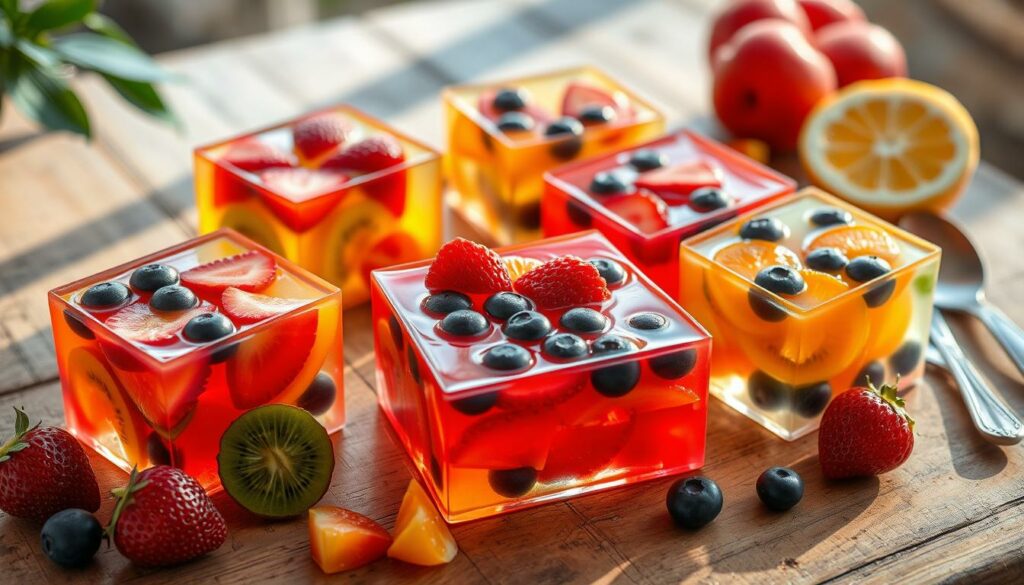Do you remember the fun of eating wobbly, fruity gelatine as a kid? You can bring back those happy moments with this simple recipe. Make your own gelatine treats with fresh fruit flavors and no artificial additives.
Making your own fruit gelatine is more than just a trip down memory lane. It’s about choosing what goes into your food and trying new things. You’ll find it’s easy to make these fun desserts. Plus, you can keep your gelatine treats in the freezer for up to 3 months, just like bread.
Looking for a light dessert, a fun family activity, or a way to eat more fruit? This guide will show you how to make perfect fruit gelatine every time. Impress your loved ones with these colorful, tasty, and healthy gelatine snacks!
Table of Contents
Key Takeaways
- Homemade fruit gelatine allows for ingredient control and customization
- The process is simple and can be a fun activity for the whole family
- Fresh fruits add natural flavors and nutritional value to your gelatine treats
- You can experiment with various fruit combinations and mold shapes
- Homemade gelatine desserts can be stored in the freezer for future enjoyment
Understanding Fruit Gelatine Basics
Fruit gelatine is a fun dessert that mixes gelatine’s bouncy feel with fruit’s sweetness. It’s great for any event because you can change it up to fit your taste. Let’s explore the basics of fruit gelatine.
What is Fruit Gelatine?
Fruit gelatine is a dessert made from gelatine powder and fruit juice or puree. The gelatine makes it wobbly. You can try many flavors by mixing different fruits and shapes.
Benefits of Homemade vs Store-Bought
Homemade fruit gelatine has many perks over store-bought. You pick the best fruits and avoid bad additives. It tastes fresher and you can make it healthier.
Essential Equipment Needed
To make tasty fruit gelatine, you need some simple tools:
- Saucepan for heating liquids
- Mixing bowls for combining ingredients
- Whisk for smooth blending
- Molds for shaping your desserts
- Measuring cups and spoons for accuracy
| Equipment | Purpose |
|---|---|
| Saucepan | Heating fruit juice or water |
| Mixing Bowls | Combining gelatine and fruits |
| Whisk | Ensuring smooth texture |
| Molds | Shaping the gelatine dessert |
| Measuring Tools | Precise ingredient portions |
How to Make Fruit Gelatine Recipe
Making a fruit gelatine recipe is easier than you think. Just follow a few steps, and you’ll have a tasty, wiggly treat. Here’s how to make a fruit gelatine recipe that will wow everyone.
First, bloom the gelatine. This step is key for the right texture. Sprinkle gelatine powder over cold water and wait for about 5 minutes. This lets the gelatine soak up the liquid and swell.
Then, warm up your fruit juice or puree. Add the bloomed gelatine to the warm liquid and stir until it’s fully dissolved. Don’t let it get too hot, as it can lose its setting power.
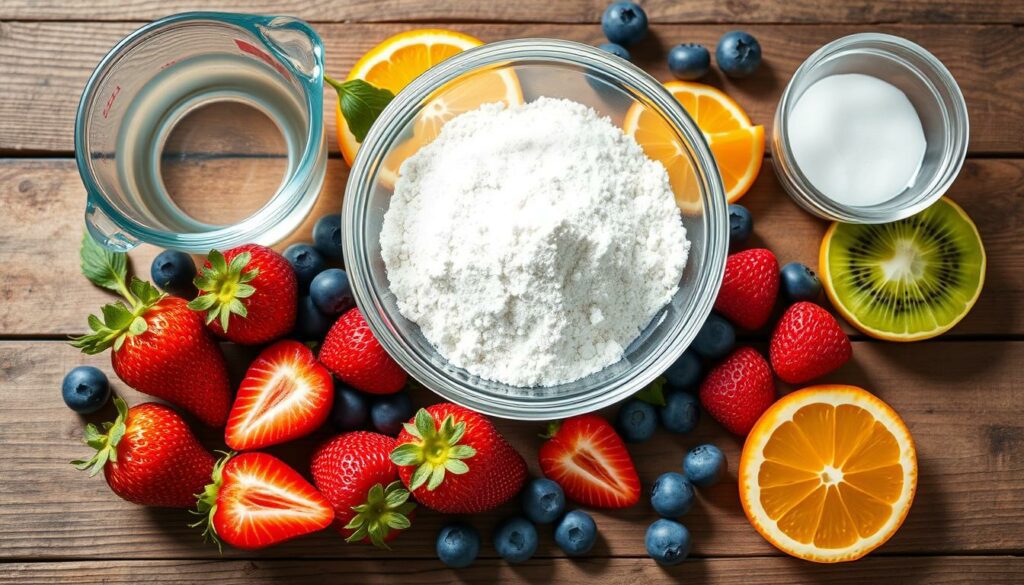
Now, add your favorite fruits. Cut them into small pieces and gently mix them into the mixture. Pour the fruit gelatine into molds and chill until it’s set, usually 4-6 hours.
| Ingredient | Amount | Purpose |
|---|---|---|
| Gelatine powder | 2 tablespoons | Setting agent |
| Fruit juice | 2 cups | Flavor base |
| Fresh fruits | 1 cup | Texture and flavor |
| Sugar | 1/4 cup | Sweetener |
Remember, controlling the temperature is crucial in this recipe. If it’s too hot, your fruits might cook. If it’s too cold, the gelatine won’t set right. With a bit of practice, you’ll get it just right every time.
Essential Ingredients for Perfect Fruit Gelatine
Making a tasty and healthy gelatine dish begins with picking the right ingredients. Let’s look at the main parts that will make your dessert stand out.
Types of Gelatine Powder
Gelatine powder comes in different types. Leaf gelatine gives a smoother feel, while powdered gelatine is easier to use. For a recipe that serves 200, you’ll need about 1/4 cup of powdered gelatine. Pick a high-quality brand for the best taste in your fruit gelatine.
Best Fruits to Use
Choose fruits that go well with gelatine’s texture. Berries, peaches, and citrus fruits are great choices. For a unique flavor, try using 6 aromatic, fruity hot peppers like habaneros. This adds a spicy touch to your healthy gelatine dish. Remember to wear gloves when handling hot peppers!
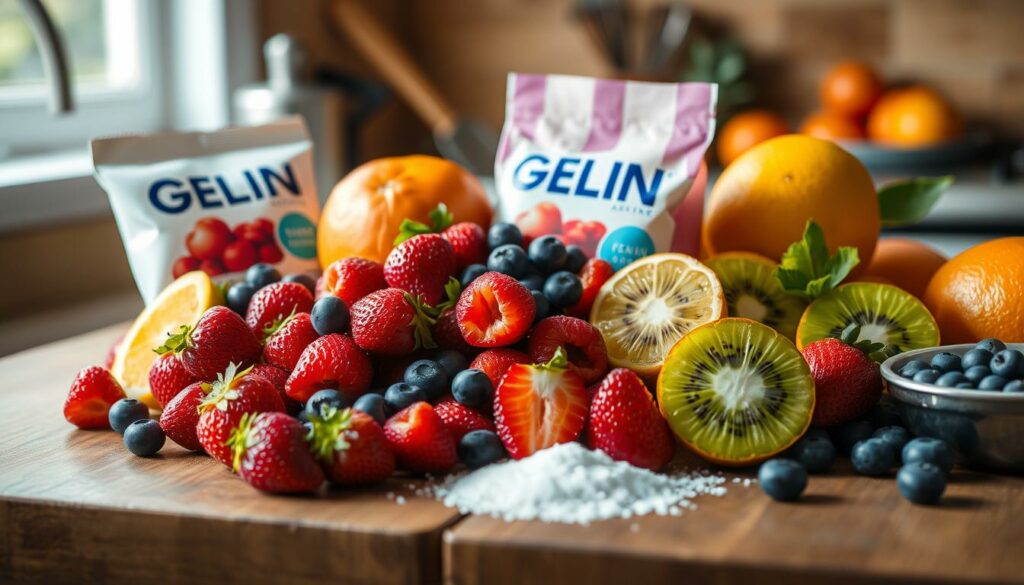
Natural Sweeteners Options
Use natural sweeteners instead of refined sugar. Honey, agave nectar, or stevia can sweeten your fruit gelatine without losing health benefits. Use about 1/4 cup of your chosen sweetener for a good flavor. Try different mixes to find your favorite.
With these ingredients, you’re set to make a delicious and healthy gelatine dish. It only takes 5 minutes to prepare, making it a quick and simple dessert. Keep your creation fresh by storing it in a quart mason jar.
Preparing Your Fruits for Gelatine Desserts
Making tasty homemade gelatine treats starts with preparing your fruits right. The right steps can make your fruit gelatine recipe amazing. Let’s look at some key ways to get your fruits ready.
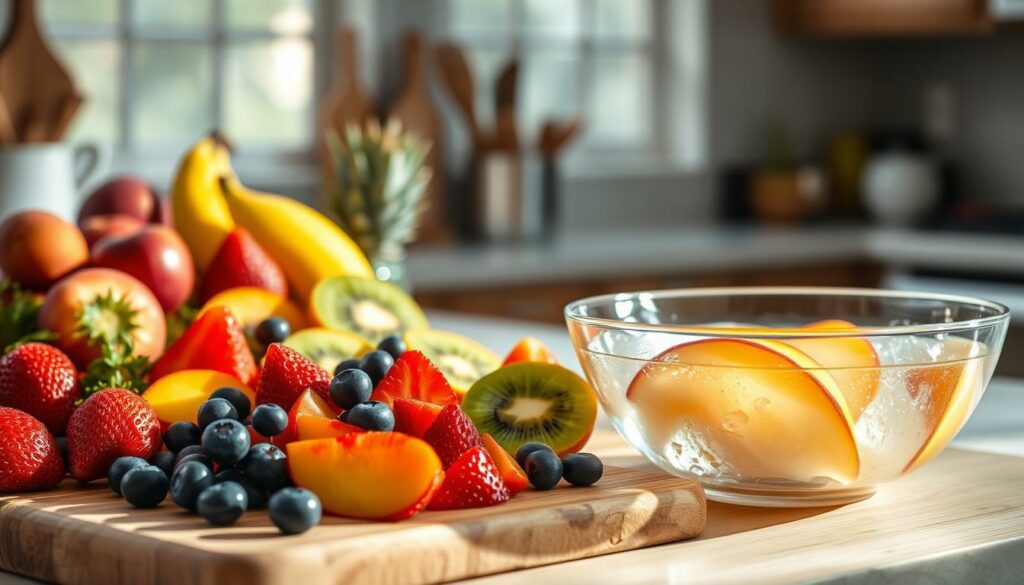
First, pick ripe, tasty fruits for your gelatine desserts. Picking seasonal fruits usually gives the best taste. Wash your fruits well and take out any stems, seeds, or pits. Cut larger fruits into small pieces so they mix well in your gelatine.
Juicing is a great way to add strong fruit flavor to your gelatine. Use a juicer or blender to get juice from fruits like oranges, strawberries, or pineapples. Strain the juice to get rid of pulp for a smoother gelatine.
For a creamier texture, puree your fruits. This works best with softer fruits like peaches or mangoes. Blend until smooth and mix the puree into your gelatine for a creamy feel.
- Slice fruits evenly for uniform distribution
- Juice fruits for intense flavor infusion
- Puree soft fruits for a creamy texture
To keep your fruits’ colors bright, try blanching them. Dip sliced fruits in boiling water for 30 seconds, then cool them down in an ice bath. This keeps their color and texture in your homemade gelatine treats.
| Fruit | Preparation Method | Best For |
|---|---|---|
| Strawberries | Sliced or pureed | Layered gelatine desserts |
| Pineapple | Juiced or chunked | Tropical gelatine flavors |
| Peaches | Pureed or sliced | Creamy fruit gelatine |
| Oranges | Juiced or segmented | Citrus-infused gelatine |
Step-by-Step Mixing Technique
Learning how to mix gelatine is key. It makes your snacks smooth and perfect. Let’s explore the main steps.
Blooming the Gelatine
Blooming gelatine is the first step. Sprinkle gelatine powder over cold water and wait for 5 minutes. This step helps the gelatine dissolve well later.
Combining Ingredients
After blooming, heat the mixture until the gelatine dissolves. Add fruits and sweeteners, stirring slowly. This ensures your gelatine is even and smooth.
Temperature Control Tips
Temperature is crucial for gelatine. Pour the mix into molds and chill quickly. For layers, chill each layer before adding the next. This patience makes your snacks look great.
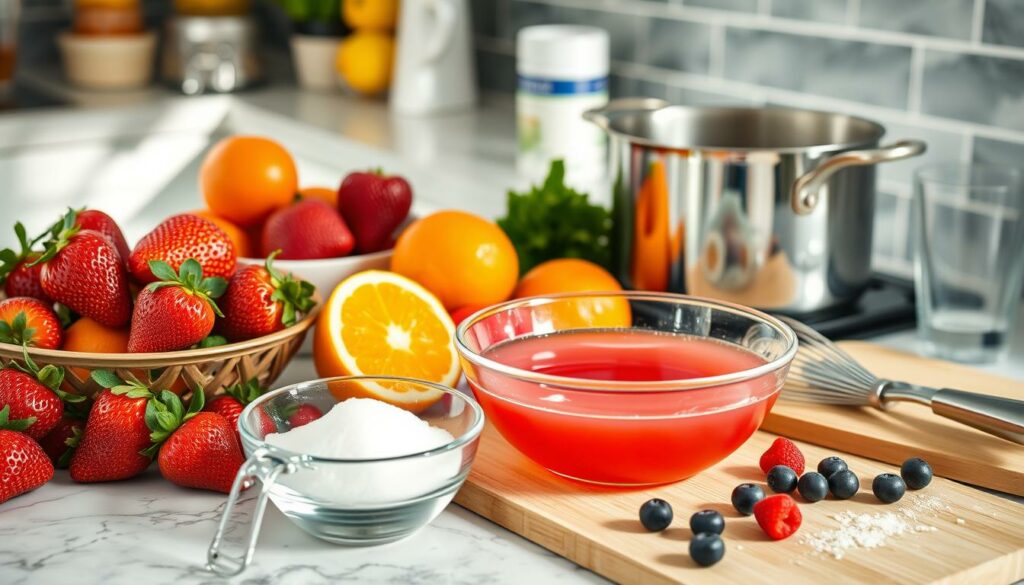
| Step | Time | Temperature |
|---|---|---|
| Blooming | 5 minutes | Cold (room temp) |
| Dissolving | 2-3 minutes | Warm (not boiling) |
| Setting | 2-4 hours | Cold (refrigerated) |
Creative Fruit Gelatine Mold Ideas
Fruit gelatine molds are a blank canvas for stunning desserts. With creativity and technique, simple ingredients become eye-catching treats. Here are some gelatine dessert ideas to wow your guests and boost your cooking skills.
Layer Techniques
Layering gelatins in different colors makes for striking desserts. Start with a base layer, let it set a bit, then add another color. Keep adding layers for a striped look. Try strawberry, lime, and lemon for a rainbow effect.
Decorative Patterns
Show off your artistic side with fruit gelatine molds. Embed fruit slices in the mold before adding gelatin. Kiwi, orange, or berries work great. For a detailed design, swirl colors with a toothpick before setting.
Special Occasion Designs
Make your fruit gelatine molds special for any occasion. Use holiday shapes and colors. For Valentine’s Day, try heart-shaped molds with strawberry gelatin. For Christmas, layer green lime and white aloe vera in a cone mold.
| Gelatin Flavor | Mold Shape | Decoration Idea |
|---|---|---|
| Watermelon | Half-sphere | Black sesame seeds as “pits” |
| Pomegranate | Dome | Pomegranate arils embedded |
| Kiwi | Round slices | Chia seeds for “kiwi texture” |
| Apple | Apple-shaped | Cinnamon stick as “stem” |
Troubleshooting Common Issues
Making homemade gelatine treats can be tricky. You might face some challenges when learning how to make fruit gelatine recipe. Let’s explore common problems and their solutions.
Texture troubles often top the list. If your gelatine is too soft, you may have used too little powder or too much liquid. Increase the gelatine powder slightly next time. For overly firm gelatine, reduce the amount of powder.
Setting issues can be frustrating. Ensure you’re using the right water temperature when blooming the gelatine. Too hot, and it won’t set properly. Too cold, and it won’t dissolve fully. Aim for lukewarm water for best results.
Flavor adjustments are key to perfecting your homemade gelatine treats. If the taste is too weak, try adding more fruit juice or puree. For overpowering sweetness, balance it out with a touch of lemon juice.
| Issue | Cause | Solution |
|---|---|---|
| Cloudy appearance | Stirring after cooling begins | Avoid stirring once cooling starts |
| Uneven setting | Uneven cooling | Ensure level surface during cooling |
| Separation of layers | Temperature differences | Cool each layer slightly before adding next |
Remember, practice makes perfect. With these tips, you’ll soon master the art of creating delicious fruit gelatine desserts.
Storage and Serving Tips
Keeping your fruit gelatine recipe fresh is key. Here are some tips to enjoy your easy gelatine snacks at their best.
Optimal Storage Conditions
Keep your fruit gelatine in an airtight container in the fridge. It stays fresh for up to 5 days. For longer storage, cut it into cubes and freeze for up to 3 months. Thaw in the fridge before serving.
Presentation Ideas
Make your fruit gelatine look great with creative presentations. Use clear glass bowls to show off the colors. For kids’ parties, cut out fun shapes with cookie cutters. Top with whipped cream for a classic look.
Serving Suggestions
Serve your gelatine chilled for the best taste. Pair it with fresh fruit or toasted coconut. For a fancy dessert, layer it with custard in parfait glasses. Remember, gelatine melts at body temperature, so enjoy it quickly!
| Storage Method | Duration | Temperature |
|---|---|---|
| Refrigerator | Up to 5 days | 35-40°F (2-4°C) |
| Freezer | Up to 3 months | 0°F (-18°C) |
Follow these tips to keep your homemade fruit gelatine delicious and looking good. Try different presentations to make your easy gelatine snacks a hit at any event.
Health Benefits and Nutritional Value
Fruit gelatine dishes are not just tasty, but also good for you. They are full of vitamins, minerals, and antioxidants from fruits. Eating fruits like apples, pomegranates, and berries can make you healthier.
The fruits you pick for your gelatine dish matter a lot. Cherries, for example, have vitamin C and polyphenols that fight inflammation. Beets add belatins, which are anti-inflammatory. Choosing many colorful fruits means your dish will have lots of nutrients.
Drinking enough water is key to staying healthy. Studies say drinking about eight cups a day can prevent health problems and help with weight loss. Fruit gelatine can help you drink more water, making it a fun way to stay hydrated.
| Health Benefit | Associated Fruit | Key Nutrient |
|---|---|---|
| Immune Support | Oranges | Vitamin C |
| Anti-Inflammatory | Cherries | Polyphenols |
| Antioxidant Boost | Blueberries | Anthocyanins |
| Gut Health | Kiwi | Fiber |
Even though fruit gelatine is healthy, it’s important to think about your own health needs. If you have certain health issues, talk to a doctor about how much water and nutrients you should have.
Kid-Friendly Variations
Making gelatine desserts for kids is a great way to get them involved in cooking. These snacks are tasty and fun to make. Let’s look at some cool variations that kids will love.
Fun Shapes and Colors
Make gelatine into fun shapes like dinosaurs or flowers. Use alphabet molds for a learning twist. Mix fruit juices for bright colors.
Try layering colors for a rainbow look. Or swirl them for a marbled effect.
Safe Ingredients for Children
Choose safe ingredients for kids’ gelatine snacks. Use natural fruit juices instead of artificial flavors. Berries are great because they can be frozen for up to 6 months.
Add pureed fruits or vegetable juices for extra nutrition. Don’t use nuts as toppings because they’re a choking hazard.
Let kids help pick fruits or mix ingredients. This makes making kid-friendly gelatine desserts a fun family activity. Always watch kids when they’re handling hot liquids.
| Fruit | Color | Kid-Friendly Benefits |
|---|---|---|
| Strawberries | Red | Sweet taste, vitamin C |
| Blueberries | Purple | Antioxidants, brain health |
| Mango | Yellow | Tropical flavor, vitamin A |
Seasonal Fruit Combinations
Discover the joy of fruit gelatine recipes with seasonal fruits. Make refreshing summer treats that change with the seasons. In spring, try strawberries and rhubarb for a tangy taste. Summer is perfect for watermelon and mint gelatine.
Fall brings pumpkin spice and apple flavors to your desserts. Winter isn’t left out! Try cranberry and orange for a festive touch. Use fresh fruits to get the best flavor and texture in your creations.
Experiment with unique pairings like mango and coconut or peach and lavender for special occasions.
Holiday Inspired Treats
Get creative with holiday-themed gelatine desserts. For Christmas, layer red and green gelatine with fruits. Valentine’s Day calls for pink strawberry hearts. Easter? Pastel-colored fruit gelatine eggs are perfect.
- Spring: Strawberry-Rhubarb Gelatine
- Summer: Watermelon-Mint Gelatine Cubes
- Fall: Pumpkin Spice Apple Gelatine
- Winter: Cranberry-Orange Gelatine Trifle
Remember, the key to great fruit gelatine is using ripe, in-season fruits. This ensures the best flavor and texture in your desserts. Don’t be afraid to mix and match fruits to create your own unique combinations. The possibilities are endless with fruit gelatine recipes!
Conclusion
Learning to make fruit gelatine at home is exciting. You’ve learned how to make tasty homemade gelatine treats. These are better than store-bought ones in taste and quality.
You now know how to pick the best fruits and mix them right. This lets you make stunning desserts for any event.
Homemade gelatine treats are very flexible. You can try different fruits, layering, and designs. This makes your desserts unique and shows off your style.
Whether it’s for kids or guests, your homemade gelatine will wow everyone. It’s a great way to impress.
As you get better at making fruit gelatine, you’ll enjoy making treats for yourself and others. So, get your molds ready, choose your favorite fruits, and start making your own fruit gelatine recipes. Your cooking journey is just starting!
FAQ
What are the basic ingredients needed for homemade fruit gelatine?
To make homemade fruit gelatine, you need gelatine powder, fruit juice or puree, water, and a sweetener if you like. Use about 2-3 tablespoons of gelatine powder for every 4 cups of liquid.
How long does it take for fruit gelatine to set?
Fruit gelatine sets in 2-4 hours, depending on the recipe and fridge temperature. For the best result, chill it overnight.
Can I use fresh fruits in my gelatine desserts?
Yes, you can use fresh fruits. But, fruits like pineapple, kiwi, and papaya have enzymes that stop gelatine from setting. Use cooked or canned versions of these fruits instead.
What’s the difference between leaf gelatine and powdered gelatine?
Leaf gelatine and powdered gelatine are the same but in different forms. Leaf gelatine is preferred by chefs for its clarity. Powdered gelatine is easier to find and measure for home cooks. Both can be used the same way with the right conversion.
How can I make vegetarian fruit gelatine?
For vegetarian gelatine, use agar-agar, carrageenan, or pectin. These are seaweed-based and work like animal gelatine. But, you need to follow specific recipes for the right ratio and method.
Why did my fruit gelatine turn out cloudy?
Cloudiness can happen from overmixing, using pulpy juices, or quick cooling. To avoid it, mix gently, use clear juices, and cool slowly before refrigerating.
Can I add alcohol to my fruit gelatine recipe?
Yes, you can add alcohol, but it changes how the gelatine sets. Use no more than 1/4 cup of 40% alcohol per 1 cup of liquid. For stronger alcohol, you might need more gelatine.
How do I create layered fruit gelatine desserts?
Make each layer separately and chill it for 30 minutes before adding the next. This way, the layers stick together without mixing.
What are some creative mold ideas for fruit gelatine?
Try using silicone molds, layering colors in a glass, or making individual servings in cups. You can also use fruit shells or add edible flowers for decoration.
How long can I store homemade fruit gelatine?
Store homemade gelatine in the fridge for 3-5 days if covered well. For the best taste and texture, eat it within 2-3 days. Don’t freeze it as it can change the texture when thawed.

